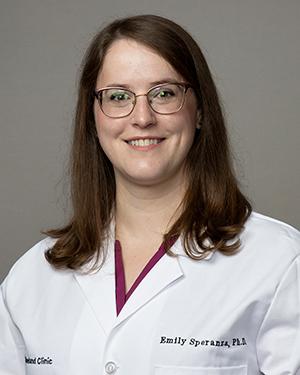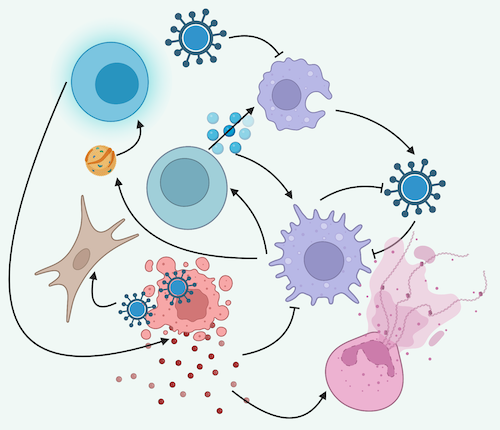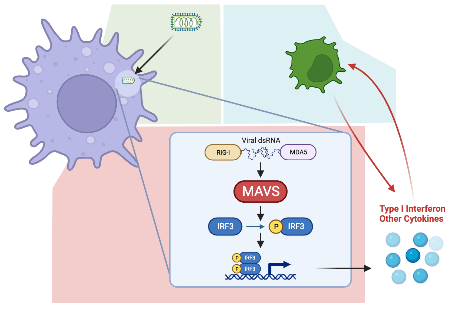Emily Speranza Laboratory
-
Emily Speranza Laboratory
- Principal Investigator
- Research
- Our Team
- Publications
- Careers

Emily Speranza, PhD
Assistant Staff
Email: [email protected]
Location:
Cleveland Clinic Florida Research & Innovation Center
Research
Hope Lab - HOst Pathogen Entaglement The host response to infections does not happen in a vacuum. The way our body responds involves complex interactions of viral pathogens with cells, cells in densely packed tissue with each other, and communication with extracellular factors. All of this creates an entanglement of immune cells with the pathogen. The HoPE lab aims to untangle these events and better define the infection microenvironment. The lab utilizes high content imaging, sequencing, and computational approaches to deeply profile in vivo infections at various tissue sites of virus replication and dissemination.
Biography
Dr. Speranza received her bachelor’s degree in 2013 from Carroll College in Helena, Montana in both biology and mathematics. She went on to receive her PhD in Bioinformatics from Boston University in 2018 where she worked at the National Emerging Infectious Disease Laboratories (NEIDL) with Dr. John H. Connor as a National Science Foundation Graduate Research Fellow. In 2018, Dr. Speranza was awarded the Rocky Mountain-Bethesda Post-doctoral fellowship award from the National Institutes of Health, National Institute of Allergy and Infectious Diseases where she worked under the mentorship of Dr. Sonja Best in the Laboratory of Virology and Dr. Ron Germain in the Laboratory of Immune System Biology. In 2020, she was appointed as an Independent Research Scholar at the National Institutes of Health to form her own research group in the Laboratory of Immune System Biology.
Education & Professional Highlights
Appointed
October 2022 - Assistant Staff
Education & Fellowships
Independent Research Scholar
National Institutes of Health
National Institute of Allergy and Infectious Diseases
Rocky Mountain - Bethesda Post-Doctoral Fellow
National Institutes of Health
National Institute of Allergy and Infectious Diseases
Graduate School - Boston University
National Science Foundation Graduate Research Fellow
Bioinformatics
Boston, MA USA
2018
Research
Overview - What is Host-Pathogen Entanglement?
Our bodies are designed with tools to fend off invading pathogens. This includes both physical barriers, like skin, and our highly evolved immune system. For a virus to be successful in replicating, it must overcome these barriers. This leads to many different pathogens evolving mechanisms to bypass the host primary defense systems. In response, the host must find unique ways to overcome the evolving pathogens.
What does this all result in? A complex battle happening inside our bodies where both the pathogen and host are attempting to outsmart the other. This battle is taking place in a dense and complex environment with other cells present and factors such as extracellular matrix proteins and lipids all affecting what the outcome of the battle may be. This creates an entangled web of interactions.

Studying a battle from both sides can help you learn what went wrong and what worked in fighting off the invader. Then, in future battles, applying this knowledge can help lead to more favorable outcomes. The main goals of the HoPE lab is to better characterize the host-pathogen interactions in these complex environments and learn the ways the host can win. We can then apply this information in the form of host-based therapeutics to give the host an edge in fighting the virus.
The research in the lab falls into three main focus areas:
- The role of MAVS in coordinating immune responses to RNA virus infections
- Characterization of how the infection microenvironment is created and maintained in barrier tissues
- Development of methods for high and maximum containment
MAVS in Host Response to Infection
What role does MAVS play in coordinating and orcherstraing the early immune response to RNA virus infections?
The Rig-I like receptor (RLR) pathway is one of the major ways in which RNA viruses, such as Ebola, Lassa, Chikungunya, and SARS-CoV-2, are first detected by an infected cell. This pathway relies on specialized receptors that specifically sense double-stranded RNA, which is a defining feature of RNA virus replication. These receptors, upon sensing RNA viruses, signal through the critical adaptor protein, MAVS, which goes on to create signals in the cells to produce interferons and cytokines. These interferons and cytokines are then excreted from the cell and signal to the environment that an infection is occurring, thus triggering a multi-cellular response.

In the lab, we are focused on understanding the role that MAVS plays in establishing and shaping a protective microenvironment around areas of infection in the tissues. In addition, we are interested in defining how the viruses ability to inhibit or antagonize this signaling can later the infection microenvironment, thus leading to better virus replication and dissemination.
Our Team
Selected Publications
View publications for Emily Speranza, PhD
(Disclaimer: This search is powered by PubMed, a service of the U.S. National Library of Medicine. PubMed is a third-party website with no affiliation with Cleveland Clinic.)
Selected Recent Publications
Speranza E, Williamson BN, Feldmann F, Sturdevant GL, Pérez-Pérez L, Meade-White K, Smith BJ, Lovaglio J, Martens C, Munster VJ, Okumura A, Shaia C, Feldmann H, Best SM, de Wit E. Single-cell RNA sequencing reveals SARS-CoV-2 infection dynamics in lungs of African green monkeys. Sci Transl Med. 2021 Jan 27;13(578):eabe8146. doi: 10.1126/scitranslmed.abe8146. Epub 2021 Jan 11. PMID: 33431511; PMCID: PMC7875333.
Speranza E, Purushotham JN, Port JR, Schwarz B, Flagg M, Williamson BN, Feldmann F, Singh M, Pérez-Pérez L, Sturdevant GL, Roberts LM, Carmody A, Schulz JE, van Doremalen N, Okumura A, Lovaglio J, Hanley PW, Shaia C, Germain RN, Best SM, Munster VJ, Bosio CM, de Wit E. Age-related differences in immune dynamics during SARS-CoV-2 infection in rhesus macaques. Life Sci Alliance. 2022 Jan 17;5(4):e202101314. doi: 10.26508/lsa.202101314. PMID: 35039442; PMCID: PMC8807873.
Radtke AJ, Kandov E, Lowekamp B, Speranza E, Chu CJ, Gola A, Thakur N, Shih R, Yao L, Yaniv ZR, Beuschel RT, Kabat J, Croteau J, Davis J, Hernandez JM, Germain RN. IBEX: A versatile multiplex optical imaging approach for deep phenotyping and spatial analysis of cells in complex tissues. Proc Natl Acad Sci U S A. 2020 Dec 29;117(52):33455-33465. doi: 10.1073/pnas.2018488117. Epub 2020 Dec 21. PMID: 33376221; PMCID: PMC7776876.
Careers
Training at Lerner Research Institute
Our education and training programs offer hands-on experience at one of the nationʼs top hospitals. Travel, publish in high impact journals and collaborate with investigators to solve real-world biomedical research questions.
Learn More